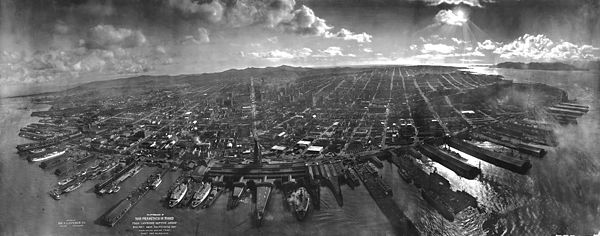- Kite aerial photography
-
Photo cervolisme
Le photo cervolisme ou photographie aérienne par cerf-volant est parfois appelé kapisme ou KAP de l'expression anglaise Kite Aerial Photograph. La méthode consiste à suspendre un appareil photo à un cerf-volant. Les dispositifs sont divers et donnent des résultats variés. L'intérêt de cette méthode réside dans l'amplitude possible : depuis 2 à 3 mètres jusqu'à 1 km d'altitude.
Historique
- 1858 : première photographie aérienne depuis un ballon captif gonflé à l’hydrogène prise par Félix Tournachon dit Nadar.
- 1862 : la photographie aérienne est utilisée par les unionistes lors de la Guerre de Sécession.
- 1880 : Le 14 juin, Paul Desmarets obtient deux clichés de Rouen en ballon captif à des altitudes de 1 100 et 1 300 m.
- 1887 : E. D. Archibald, un météorologiste anglais, aurait prit la première (?) photo aérienne par cerf-volant. Cette première observation fut vite répétée et mise à profit en archéologie, géologie, cartographie, observation militaire, etc.
- 1888 : Arthur Batut mène les premiers essais de photographie aérienne par cerf-volant en France. Il utilise un cerf-volant plat de 4,3 m² sous lequel était accrochée une chambre de 8 × 10 cm. Ce dispositif lui permet d’atteindre des altitudes de quelque centaines de mètres. L’obturateur est commandé par une mèche d’artificier allumée au départ et dont la longueur était calculée d’avance.
- 1891 : fort de l’expérience de Arthur Batut, Émile Wenz perfectionne la méthode en se servant de l’électricité pour le déclenchement. Il obtient des vues de la plage de Berck (Pas-de-Calais). Dès lors, de nombreux « aérophotographes » vont se succéder, faisant de Berck-Plage, le site le plus photographié des airs avant la Première Guerre mondiale.
- 1896 : Arthur Batut photographie le village de Labruguière dans le Tarn. Il utilisait une mèche et de l’amadou. Le matériel qu’il utilise est aujourd’hui visible au musée qui lui est consacré.
- 1899 : à l’observatoire de Trappes, des sondes aériennes ont atteint la hauteur de 3 500 m, avec 8 cerfs-volants de 5 m² chacun, disposés à 500 m les uns des autres.
- 1903 (env.) : Joseph Lecornu innove en dissociant cerf-volant principal et cerf-volant remorqueur de l’appareil photographique. Ce qui évite de descendre le cerf-volant après chaque prise de vues.
- 1914 - 1918 : le ballon joue un rôle stratégique. Entre 1915 et 1918, le Capitaine Cacquot a mis au point un ballon utilisable par grand vent. Au cours de la Première Guerre mondiale, on voit également apparaître les premières ascensions humaines en cerf-volant. C’est au Capitaine Saconney que l’on doit l’invention de ce système.
- 1930 - 1935 : L'égyptologue Pierre Montet obtient plusieurs photographies aériennes par cerf-volant du site du grand temple d’Amon à Tanis en Égypte.
Voir aussi
Liens externes
- (fr) Du ciel Du ciel, site de Thomas Sagory, archéologue, photo cervoliste
- (fr) David Merlin, photographie aérienne par cerf-volant Site de David Merlin, aérophotographe cerf-voliste professionnel.
- (en) Kite aerial photograph
- (fr) Musée Arthur Batut
- (fr) Espace Arthur Batut
- Portail de la photographie
- Portail de l’aéronautique
Catégories : Genre, thème ou discipline photographique | Activité aérienne | Cerf-volant
Wikimedia Foundation. 2010.

